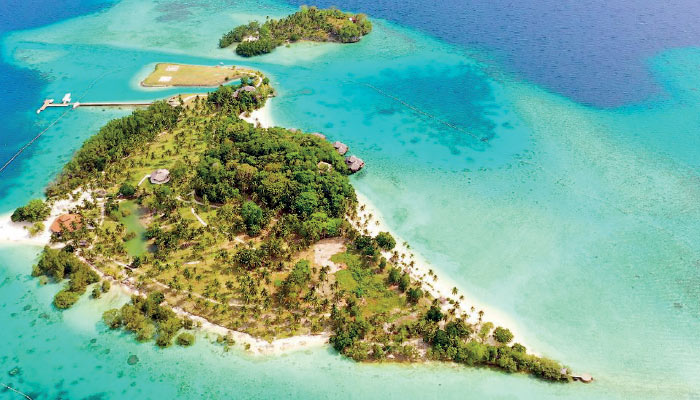Sunday Dec 14, 2025
Sunday Dec 14, 2025
Monday, 14 July 2025 00:37 - - {{hitsCtrl.values.hits}}

The BJP’s decision to revive the Katchatheevu issue—50 years after the agreement—is politically significant
 The underlying objective of this move by the BJP appears to be strategic entry into Tamil Nadu’s political landscape, which has long been dominated by Dravidian ideology, particularly the legacy of Thanthai Periyar. Tamil Nadu has traditionally shown less appetite for religious or Hindutva politics, making it a challenging terrain for the BJP. Raising the Katchatheevu issue allows the party to embarrass the DMK, which held power in Tamil Nadu during the time of the original agreement. Some observers also interpret it as a tactical move to pressure or checkmate Sri Lanka, thereby increasing India’s leverage over the current administration in Colombo
The underlying objective of this move by the BJP appears to be strategic entry into Tamil Nadu’s political landscape, which has long been dominated by Dravidian ideology, particularly the legacy of Thanthai Periyar. Tamil Nadu has traditionally shown less appetite for religious or Hindutva politics, making it a challenging terrain for the BJP. Raising the Katchatheevu issue allows the party to embarrass the DMK, which held power in Tamil Nadu during the time of the original agreement. Some observers also interpret it as a tactical move to pressure or checkmate Sri Lanka, thereby increasing India’s leverage over the current administration in Colombo
 For successive Sri Lankan Governments and the people of Sri Lanka, the subject of Katchatheevu has long been viewed as conclusively resolved through two bilateral agreements signed with India in 1974 and 1976. However, the issue continues to resonate in Tamil Nadu, where political and emotional sensitivities remain.
For successive Sri Lankan Governments and the people of Sri Lanka, the subject of Katchatheevu has long been viewed as conclusively resolved through two bilateral agreements signed with India in 1974 and 1976. However, the issue continues to resonate in Tamil Nadu, where political and emotional sensitivities remain.
As someone who served as Sri Lanka’s Deputy High Commissioner in Chennai from 2006 to 2009, a period that coincided with the final stages of the conflict in Sri Lanka, I witnessed firsthand the heightened sentiments in Tamil Nadu. The military offensive in the North of Sri Lanka provoked strong reactions, including nearly a dozen incidents of self-immolation in protest. The Katchatheevu issue, often confined to Tamil Nadu’s political discourse, resurfaced as opposition parties such as the AIADMK and its allies blamed the DMK for “handing over” (tharaivarthal) the island to Sri Lanka.
During my tenure, I observed very limited discussions on the issue beyond Tamil Nadu. In my understanding, those in New Delhi had viewed the Katchatheevu matter as settled, much like the view held in Colombo.
Against this backdrop, it was surprising—both to me and many others familiar with Indian politics—when, during the 2024 Lok Sabha election campaign, Prime Minister Narendra Modi and other BJP leaders reignited the issue. They even released archival documents to support their claim that the Congress government had acted against national interests in “ceding” the island.
The underlying objective of this move by the BJP appears to be strategic entry into Tamil Nadu’s political landscape, which has long been dominated by Dravidian ideology, particularly the legacy of Thanthai Periyar. Tamil Nadu has traditionally shown less appetite for religious or Hindutva politics, making it a challenging terrain for the BJP. Raising the Katchatheevu issue allows the party to embarrass the DMK, which held power in Tamil Nadu during the time of the original agreement. Some observers also interpret it as a tactical move to pressure or checkmate Sri Lanka, thereby increasing India’s leverage over the current administration in Colombo.
In this context, it becomes pertinent to delve into the Katchatheevu issue from the Indian, Tamil Nadu, and Sri Lankan perspectives, as it has the potential to evolve into a point of irritation if not of point of friction in bilateral relations.
Geographical and legal context
The maritime boundary between Sri Lanka and India is demarcated at three distinct points:
Bay of Bengal in the north,
Palk Strait in the middle, and
Gulf of Mannar in the south.
The distance between the two countries across the Palk Strait varies between 16 km (Dhanushkodi–Talaimannar) and 45 km at its widest. Neither country has Exclusive Economic Zones (EEZs) in this narrow region, but both retain sovereign rights over territorial waters up to 12 to 22 km.
India and Sri Lanka signed:
The Agreement between Sri Lanka and India on the boundary on historic waters between the two countries and related matters (Katchatheevu Agreement) in June 1974, and
Agreement between Sri Lanka and India on maritime boundary between the two countries in the Gulf of Mannar and Bay of Bengal and related matters in March 1976.
Katchatheevu is a small, inhabited island in the Palk Strait, located nine miles (14.48 km) south of Delft Island and ten miles (16.09) northeast of Rameswaram. It measures roughly 1.6 km in length, 365 yards at its widest point, and covers an area of about 285 acres or 1.15 square kilometres.
For many in Tamil Nadu—especially fisherfolk communities—Katchatheevu holds emotional and livelihood significance, as they have traditionally fished in its surrounding waters. The St. Anthony’s Church on the island, visited by both Sri Lankan and Indian Catholics, is believed to have been built in the early 20th century by Seenikuppan Padayachi, a fisherman from Ramanathapuram, in fulfilment of a vow.
Historical claims and legal disputes
According to V. Suryanarayanan, a renowned Tamil Nadu academic “Katchatheevu formed part of the Zamindari of Ramnad, and the Raja of Ramnad exercised control and ownership over the island.” He notes that “the legal dispute between British Ceylon and British India began as early as 1921, during a meeting in Colombo between the Madras Presidency and Ceylon officials. In that meeting, Mr. Horsburgh, head of the Ceylon delegation, proposed that delimitation should follow the median line, so as to include the islet of Katchatheevu and three miles to the westward.” The British Indian delegation could not provide any valid argument regarding the ownership except to state that Katchatheevu fell under the Ramnad Zamindari, was regularly leased, and that rent was being collected, thus indicating active ownership.
From reviewing the historical record, it seems that the Central Government in New Delhi at times soft-pedalled the matter, prioritising good relations with Sri Lanka over Tamil Nadu’s objections. Tamil Nadu’s primary claim rested on the island being part of the Ramnad Zamindari. New Delhi, while not necessarily disputing that claim, maintained that Zamindari rights did not equate to sovereignty.
In contrast, Sri Lanka maintained a consistent position—both before and after independence—that Katchatheevu was an integral part of Sri Lankan territory. This position was upheld during colonial time and successive Governments after independence.
Former Sri Lankan Secretary Ministry of External Affairs and Defence, W.T. Jayasinghe, in his book titled “Katchatheevu and the Maritime Boundary of Sri Lanka” addressed the misconception in both India and Sri Lanka that India had “gifted” or “ceded” Katchatheevu to Sri Lanka as a goodwill gesture. His book adequately describes the early history and usage of the waters between Sri Lanka and India. He proves that Sri Lanka’s sovereignty over Katchatheevu was clear even from colonial time. Jayasinghe, an outstanding public servant accompanied Prime Minister Sirimavo Bandaranaike during her talks with Prime Minister Indira Gandhi in the 70s.
Why the BJP revived the issue
In this context, the BJP’s decision to revive the Katchatheevu issue—50 years after the agreement—is politically significant. Analysts identify three key motivations:
Electoral expansion in Tamil Nadu: The BJP, with limited success in the state, seeks to tap into Tamil nationalist sentiments, especially among fisherfolk and coastal communities.
Targeting the Congress: The party uses Katchatheevu to attack the Congress, which signed the 1974 agreement under Indira Gandhi, portraying it as a failure to protect India’s territorial integrity.
Broader nationalist agenda: The BJP frames the ceding of the island as part of a series of compromises that weakened India, aligning with its assertive foreign policy stance on territorial disputes—be it with Pakistan, China, or now Sri Lanka.
A new tension in bilateral relations?
Contrary to the belief in Sri Lanka that the Katchatheevu issue was conclusively settled through the 1974 Agreement in some Indian political quarters there is a simmering argument to connect the 1974 Agreement with the implementation of 1987 Indo-Sri Lanka Agreement under which devolution of power to the provinces was introduced. I heard it loud and clear during my stint in Chennai, on many social occasions. “If Sri Lanka refuses to honour its 1987 commitment to India, why should India uphold its 1974 agreements with Sri Lanka?”
This line of reasoning could gain momentum, particularly if New Delhi’s political leadership seeks to assert regional dominance or exert pressure on Colombo. Whether this represents a genuine policy shift or merely an election-time manoeuvre remains to be seen. While many in Sri Lanka are quick to dismiss it as a purely electoral tactic, I do not share that view.
(The writer is former Sri Lanka Ambassador to EU, Belgium, Saudi Arabia and Turkey, and former Deputy High Commissioner in Chennai.)